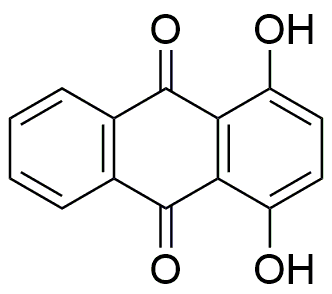Quinizarin is widely utilized in research focused on:
- Dyes and Pigments: Commonly used as a dye in textiles and plastics, offering vibrant colors and excellent lightfastness, making it ideal for products that require durability.
- Analytical Chemistry: Employed as a reagent in various analytical methods, particularly in the detection of metal ions, providing a reliable way to assess material purity and composition.
- Organic Synthesis: Acts as an intermediate in the synthesis of other organic compounds, facilitating the development of new materials in pharmaceuticals and agrochemicals.
- Biological Research: Utilized in studies involving fluorescence microscopy, helping researchers visualize cellular structures and processes due to its fluorescent properties.
- Environmental Monitoring: Applied in the detection of pollutants in water and soil, aiding environmental scientists in assessing contamination levels and ensuring safety.
General Information
Properties
Safety and Regulations
Applications
Quinizarin is widely utilized in research focused on:
- Dyes and Pigments: Commonly used as a dye in textiles and plastics, offering vibrant colors and excellent lightfastness, making it ideal for products that require durability.
- Analytical Chemistry: Employed as a reagent in various analytical methods, particularly in the detection of metal ions, providing a reliable way to assess material purity and composition.
- Organic Synthesis: Acts as an intermediate in the synthesis of other organic compounds, facilitating the development of new materials in pharmaceuticals and agrochemicals.
- Biological Research: Utilized in studies involving fluorescence microscopy, helping researchers visualize cellular structures and processes due to its fluorescent properties.
- Environmental Monitoring: Applied in the detection of pollutants in water and soil, aiding environmental scientists in assessing contamination levels and ensuring safety.
Documents
Safety Data Sheets (SDS)
The SDS provides comprehensive safety information on handling, storage, and disposal of the product.
Product Specification (PS)
The PS provides a comprehensive breakdown of the product’s properties, including chemical composition, physical state, purity, and storage requirements. It also details acceptable quality ranges and the product's intended applications.
Certificates of Analysis (COA)
Search for Certificates of Analysis (COA) by entering the products Lot Number. Lot and Batch Numbers can be found on a product’s label following the words ‘Lot’ or ‘Batch’.
*Catalog Number
*Lot Number
Certificates Of Origin (COO)
This COO confirms the country where the product was manufactured, and also details the materials and components used in it and whether it is derived from natural, synthetic, or other specific sources. This certificate may be required for customs, trade, and regulatory compliance.
*Catalog Number
*Lot Number
Safety Data Sheets (SDS)
The SDS provides comprehensive safety information on handling, storage, and disposal of the product.
DownloadProduct Specification (PS)
The PS provides a comprehensive breakdown of the product’s properties, including chemical composition, physical state, purity, and storage requirements. It also details acceptable quality ranges and the product's intended applications.
DownloadCertificates of Analysis (COA)
Search for Certificates of Analysis (COA) by entering the products Lot Number. Lot and Batch Numbers can be found on a product’s label following the words ‘Lot’ or ‘Batch’.
*Catalog Number
*Lot Number
Certificates Of Origin (COO)
This COO confirms the country where the product was manufactured, and also details the materials and components used in it and whether it is derived from natural, synthetic, or other specific sources. This certificate may be required for customs, trade, and regulatory compliance.


